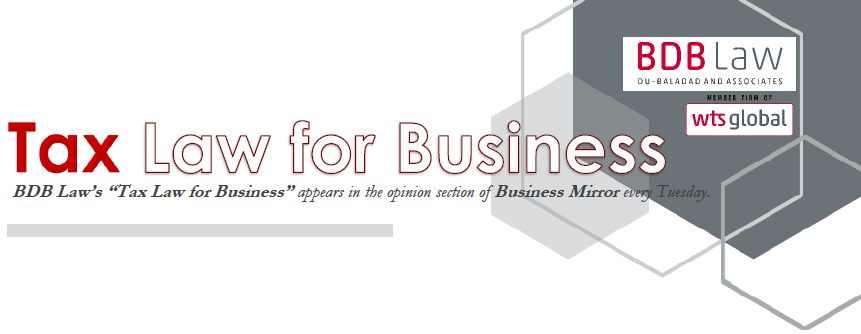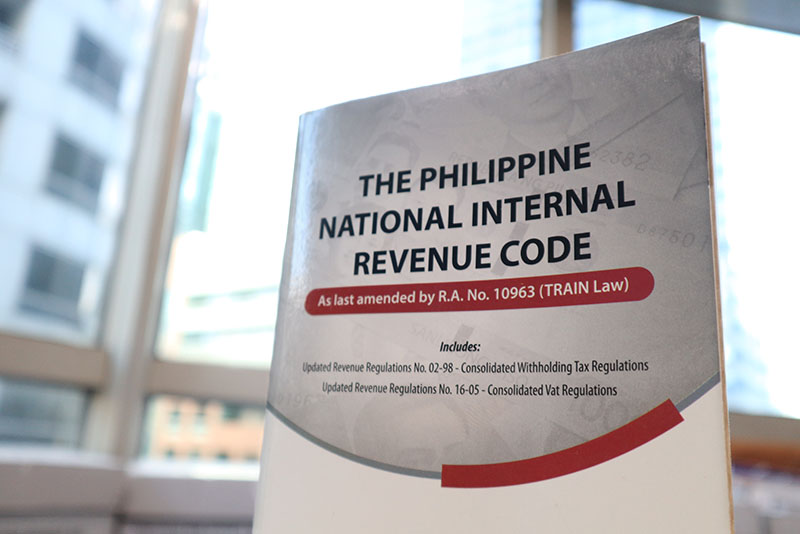
Dividends to Non-Residents:
Tax Sparing Provision or Tax Treaty
By: Atty. Mabel L. Buted
"While the rates are important, the procedures for the availment of the reduced rates on dividends are also essential in determining which one to avail. Separate issuances define the guidelines for the availment of the reduced rates under both instances. Revenue Memorandum Order No. 046-20 provides for the procedures in availing the 15% rate under the tax sparing rule. Under this RMO, the reduced rate of 15% may be applied outright by the withholding agent. However, within 90 days from the remittance of the dividends, or from the determination by the foreign tax authority of the deemed paid tax credit/non-imposition of tax because of the exemption, whichever is later, the foreign corporation shall file with the International Tax Affairs Division of the BIR a request for confirmation for the applicability of the reduced dividend rate of 15%."
The reduction starting this year of the corporate income tax rate applicable on income derived from sources within the Philippines by non-resident foreign corporations (NRFCs) to 25% necessarily reduced the final withholding tax rate to the same rate. The income subject to the new rate includes dividends. It follows that the final withholding tax rate that should generally be used by the Philippine investee corporations when paying dividends to their corporate foreign shareholder shall be 25%.
 There is, however, a provision in the Tax Code (usually referred to as the tax sparing credit provision) allowing a reduction of the 25% tax rate to 15%, on the condition that the country in which the non-resident foreign corporation is domiciled allows a credit against the tax due from the non-resident foreign corporation taxes deemed to have been paid in the Philippines equivalent to 10%. This deemed paid tax credit is the difference between the regular tax rate (now at 25%) and the 15% reduced tax rate. An old decision of the Supreme Court interpreted this rule to include an instance where the country of residence of the corporate stockholder exempts from tax the dividends derived from the Philippines.
There is, however, a provision in the Tax Code (usually referred to as the tax sparing credit provision) allowing a reduction of the 25% tax rate to 15%, on the condition that the country in which the non-resident foreign corporation is domiciled allows a credit against the tax due from the non-resident foreign corporation taxes deemed to have been paid in the Philippines equivalent to 10%. This deemed paid tax credit is the difference between the regular tax rate (now at 25%) and the 15% reduced tax rate. An old decision of the Supreme Court interpreted this rule to include an instance where the country of residence of the corporate stockholder exempts from tax the dividends derived from the Philippines.
Another alternative for the reduction of the final tax on dividends due to non-residents is through the availment of tax treaty benefits. For dividends, the maximum rates provided in these treaties range from 10% to 25%. There are exceptional instances where 5% could apply. Of course, the application of these preferential rates are subject to conditions defined in the respective treaties.
So there are two instances where the 25% tax rate on dividends may be reduced. One is through the availment of the preferential tax rates provided in the tax treaties. The other instance is through the availment of the tax sparing provision in our Tax Code.
Are taxpayers mandated to follow either of these or to choose which one to apply? No. Taxpayers may not in fact avail of the reduced rates and instead apply the 25% rate under the Tax Code. But if a taxpayer is considering the use of lower rates, it has to determine first whether these are applicable. For the tax treaty to apply, there has to be an existing tax treaty between the Philippines and the country of the recipient shareholder. There are more than forty tax treaties which the Philippines had concluded with other countries. If the shareholder is not a resident of any of these countries, no treaty and accordingly, no preferential tax treaty rate will apply. On the other hand, for the tax sparing provision to apply, the country of residence of the shareholder should either exempt the dividends received by the shareholder from income tax or allows a tax credit for the tax deemed paid in the Philippines equivalent to 10%. If not, the tax sparing provision will not apply.
By the way, the tax sparing provision does not apply to individual shareholders. It applies only if the shareholder is a non-resident foreign corporation. So if the shareholder is a non-resident individual, the reduction in rate can only be availed through the tax treaty, if one is applicable.
Should the NRFC be entitled to avail of a reduced rate either under the tax treaty or through the tax sparing provision, one important factor is the rate. The reduced rate under the tax sparing rule is fixed at 15%. But tax treaties provide for varied rates, subject to conditions. The imposable rate could also be 15% but it could be higher or lower. The difference between the rate provided in the treaty and the 15% tax sparing rate may determine which one to avail.
While the rates are important, the procedures for the availment of the reduced rates on dividends are also essential in determining which one to avail. Separate issuances define the guidelines for the availment of the reduced rates under both instances. Revenue Memorandum Order No. 046-20 provides for the procedures in availing the 15% rate under the tax sparing rule. Under this RMO, the reduced rate of 15% may be applied outright by the withholding agent. However, within 90 days from the remittance of the dividends, or from the determination by the foreign tax authority of the deemed paid tax credit/non-imposition of tax because of the exemption, whichever is later, the foreign corporation shall file with the International Tax Affairs Division of the BIR a request for confirmation for the applicability of the reduced dividend rate of 15%.
For the availment of tax treaty benefits, Revenue Memorandum Order No. 14-2021 returned the requirement for the application for tax treaty relief. This covers all types of income payments entitled to treaty benefits, including dividends. The reduced rate under the treaty may also be applied outright subject to a subsequent request for confirmation on the propriety of the withholding tax rate applied. The request for confirmation shall be made any time after the close of the taxable year but not later than the last day of the fourth month following the close of such taxable year. If the withholding agent does not apply the treaty rate and instead applies the 25% tax rate under the Tax Code, the income recipient or its authorized representative may file a tax treaty relief application, as well as an application for refund, any time after the payment of the withholding tax.
So in either case, there has to be an application/request for confirmation of the application of the reduced rate. The difference lies in the period for filing the application/request, the documentary requirements for the filing, as well as the regularity in filing. There is no preferred option. That depends on the circumstances of the transaction and the parties involved. One has to note, however, that in the availment of the tax sparing provision, the law granting tax exemption or the allowance of tax credit in the country of residence of the income recipient has to be substantiated. That is not required in the availment of tax benefit as the treaty itself serves as the law that governs the entitlement to the preferential rate.
The author is a senior associate of Du-Baladad and Associates Law Offices (BDB Law), a member-firm of WTS Global.
The article is for general information only and is not intended, nor should be construed as a substitute for tax, legal or financial advice on any specific matter. Applicability of this article to any actual or particular tax or legal issue should be supported therefore by a professional study or advice. If you have any comments or questions concerning the article, you may e-mail the author at This email address is being protected from spambots. You need JavaScript enabled to view it. or call 8403-2001 local 312.



